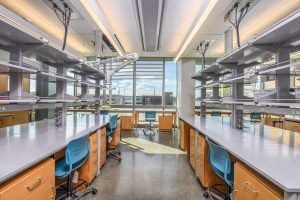FSU’s EOAS BUILDING: Where Climate Collides
Home to one of the top planetary science programs in the United States, Florida State University’s earth, ocean, and atmospheric science (EOAS) department performs cutting-edge research that helps communities around the country prepare for and respond to natural disasters. But before last year, these intertwined disciplines were scattered across eight buildings on FSU’s campus.

Over six years ago, Florida State University (FSU) realized the need to consolidate environmental science, geology, meteorology, and oceanography under one roof. The university partnered with Bohlin Cywinski Jackson Architects and Ajax to create a buildable design that would truly integrate these fields of study while incorporating the EOAS department’s big ideas for the future.
EARLY ACTION
Knowing labs would be a huge portion of this facility, FSU engaged Ajax early in the design process, which allowed the construction team to advise on constructability every step of the way. The building houses over 30 research and teaching labs—each individually equipped for a distinct purpose. From compressed air supplies to specialty fume exhausts, all labs required a unique set of systems, which the team coordinated us-ing BIM and installed in the space above the ceilings. “Most of the labs needed several of the same systems, but it wasn’t like each lab was a copy of the next,” says Quinn Toulon, senior project manager at Ajax. “Every lab was a coordination effort to make sure that each fume hood, lab bench, and section of fixtures was exactly what the user of that lab was going to need.”
And several of the specialty labs called for even more intricate problem-solving. The trace metals lab, for instance, had to be built entirely of non-metal materials so the room wouldn’t interfere with the research. The project team worked closely with sub-contractors to find non-metal alternatives, like plastic cabinets, plastic faucets, and a non-metal HEPA filtering system.
NEW ADDITIONS
On top of the labs, FSU wanted to take the EOAS building beyond the basics for both teaching and research. The new facility features a handful of distinct elements to aid the department’s world-class studies.
Science on a Sphere. In line with the EOAS department’s mission for the new building—to better integrate the complex studies of the earth and its systems—Science on a Sphere uses custom software, computers, and video to display tons of data from across the environmental science spectrum. It looks like a room-sized globe and is meant to help students visualize patterns in the weather, wind, currents, tectonic movements, and more. Ajax helped prepare the space for the sphere, which arrived earlier this year. The team installed a ceiling soffit, the electrical and data infrastructure, and a stain-less-steel guardrail to protect the display from passersby.
Seismometer. Only one of a handful in the state of Florida, the university now has its own seismometer that can detect seismic activity around the globe. Ajax drilled 150ft down to provide a sleeve for the device, which gathers data for staff and students to study in real-time.
Smart flower. An impressive solar panel system, FSU’s smart flower sits on the roof of the new building and tracks the movement of the sun via GPS location, allowing it to absorb and produce as much energy as possible. The device is self-cleaning, will fold up automatically in the event of high winds, and produces 2.5kW of electricity. Its data is displayed on the monitors in the main corridor of the building.
Monitoring well. Ajax drilled for and installed a casing for monitoring the well, which provides a pathway to Florida’s aquifer. EOAS staff and students can use this well to collect samples from hundreds of feet below the earth’s surface.
Observation deck. 80ft above grade, the building has a 1,400sf rooftop observation deck primarily dedicated to meteorology research.
“The more we worked on these high-tech elements, the more we learned about each subject and how it’s taught at the university level,” says Dane Chrestensen, assistant project manager at Ajax. “Building a space meant to bridge the gaps between disciplines, while providing access to some of the most advanced resources, was a very unique and rewarding experience.”
THINKING GREEN
In a building dedicated to studying the planet, it only makes sense that sustainability was a big focus throughout construction. The facility’s LED lighting system controls are tied into the HVAC system, and a variable air volume system is tied to occupancy sensors. This means the building can detect when rooms are empty and adjust the heating, cooling, and lighting to conserve energy. Together with the construction and design teams, FSU is in the process of securing a LEED Silver certification for the space.
Today, the seven-story structure is a prominent fixture on the FSU campus, surpassing Doak Campbell Stadium as the tallest building on school grounds. The new facility welcomed faculty and students in January 2020.
